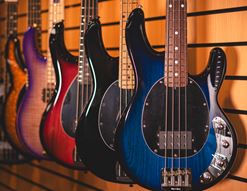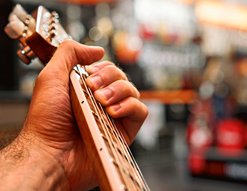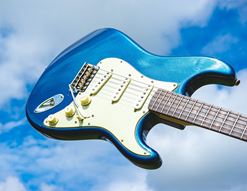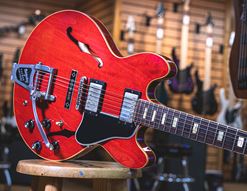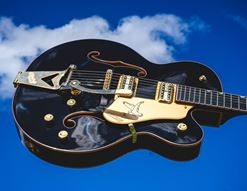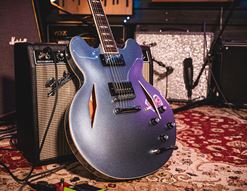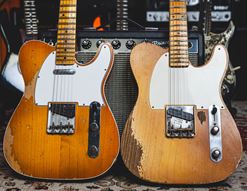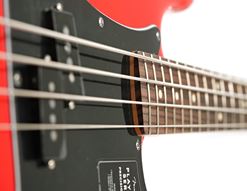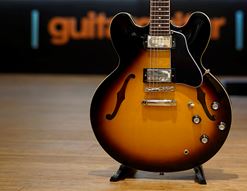You’d like to buy a classical guitar? Excellent! It’s an instrument of real elegance and expression. Learning to play a selection of pieces on a nylon string guitar can open up your playing in a number of directions, so it’s a great idea to have a classical guitar in your armoury.
But which model should you go for? What sort of features and build elements should you be aware of and go for when buying? They all look so similar!
Indeed they do, but as you can tell from checking out the price tags, they are most definitely not all the same! Today, my aim is to arm you with some pieces of knowledge that may come in handy when figuring out your next move. I’ll look at the main areas that you’ll want to draw your attention to, and I’ll talk about what you might want to look for.
If that sounds good then get yourself comfy for five minutes and I’ll pass my knowledge across to you!
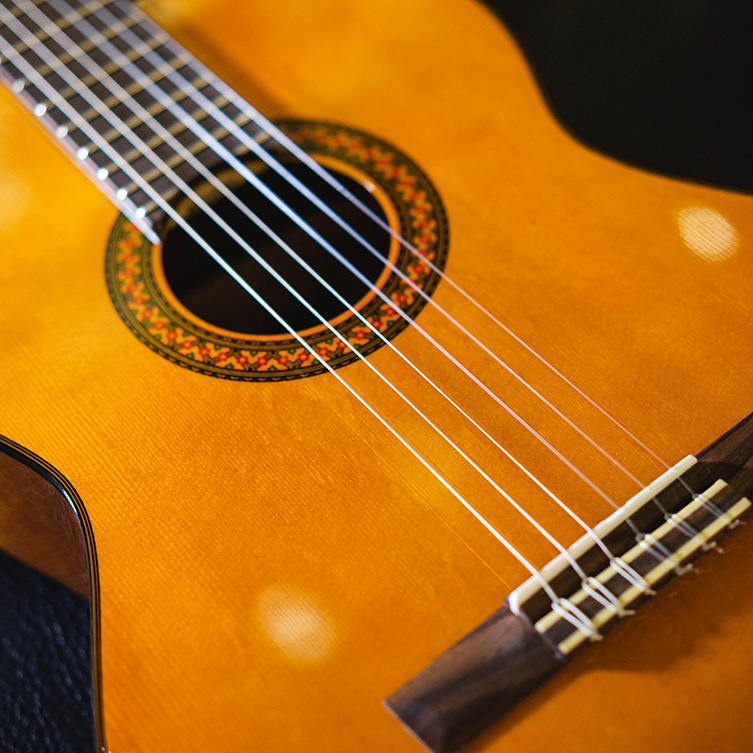
Contents
Which Classical Guitar Should I Buy?
Today’s Aim
When looking for a classical guitar, I’d say that the most important things are the following:
- Sound quality
- Feel
- Comfort
Everything else comes after that, in my experience. Cost is obviously a factor for everybody, but I’m actually leaving that one out of the blog today. Why? Well, it’s no use talking about guitars that are either far above your price range or way below the level you’re aiming at. You’ll know how much you want to pay for your new classical guitar: it’s my task today to arm you with the facts that’ll help get the best guitar your money can buy into your hands. The same factors are involved in assessing a guitar at any price, really. The only differential is that, in a perfect world, you’ll encounter far less problems and compromises the higher up in price you travel.
Sound Quality
So, sound quality is the most important thing. That seems obvious when we say it, but not everybody puts that at the top of their agenda, to be honest. Plenty of guitar players get used to reading specs online, whether here on the guitarguitar website or on some manufacturer’s web page. Spec lists can be useful when comparing certain features (or indeed learning about models and so on) but it’s hardly the same as having your own subjective point of view on what a guitar’s sound is like. For that, you need to try it out, of course.
But what is a ‘good sound’? I’d break it down into attack, sustain and colour. Attack is how snappy the notes are, and whether there’s a ‘bloom’ in there between the moment you play a note and when the note reaches its full sonorous sound. Attack refers to a response, really, and you’ll be able to assess how much you like a guitar’s attack simply by trying it alongside others.
Sustain is obvious, and is actually a great litmus test for the guitar’s overall quality: if there are bags and bags of sustain available on every note, that’s a sign that the build quality is generally excellent. How come? Because it’s an indicator that nothing is getting in the way of the note ringing out and having the resonance happen in a natural way.
As for colour, you could substitute that word for ‘brightness’ if you wanted, but I don’t want to make the assumption that ‘bright’ equals ‘better’. Many players love cedar tops on classicals because they actually warm up the sound and add some depth that isn’t always there with spruce.
So, instead of me telling you what’s good and bad, just be mindful of this stuff, and have opinions of what you think about it all. It’s your sound and your guitar, after all!
Does Wood Matter?
Talk of ‘sound’ or ‘tone’ will inevitably lead towards a discussion of tonewoods. I’ve already mentioned the relative properties of cedar (warm, deep) and spruce (bright, focussed). These are the main two wood species used for making guitar tops, also known as soundboards. The soundboard is the most significant part of a classical guitar in terms of sound. It resonates to produce the frequencies and overtones that make up the greater part of the guitar’s sound. The back and sides kind of capture and ‘shape’ that sound, adding a little colour with whatever timbers they are made with.
Body shape plays a part here too, and whilst it’s a bit of a tangent (so I won’t go too far with it here), you can actually look at a guitar and roughly translate the body shape into what kind of tones to expect. If the ‘waist’ is prominent, there will generally be less midrange; a large lower bout (or bigger body in general) means more bass/low-end, and the same applies for the upper bout (where cutaways are if the guitar has them): more here means generally more treble.
It’s not a hard and fast rule, since timber choice plays such a large part in the process, but there is an influence there.
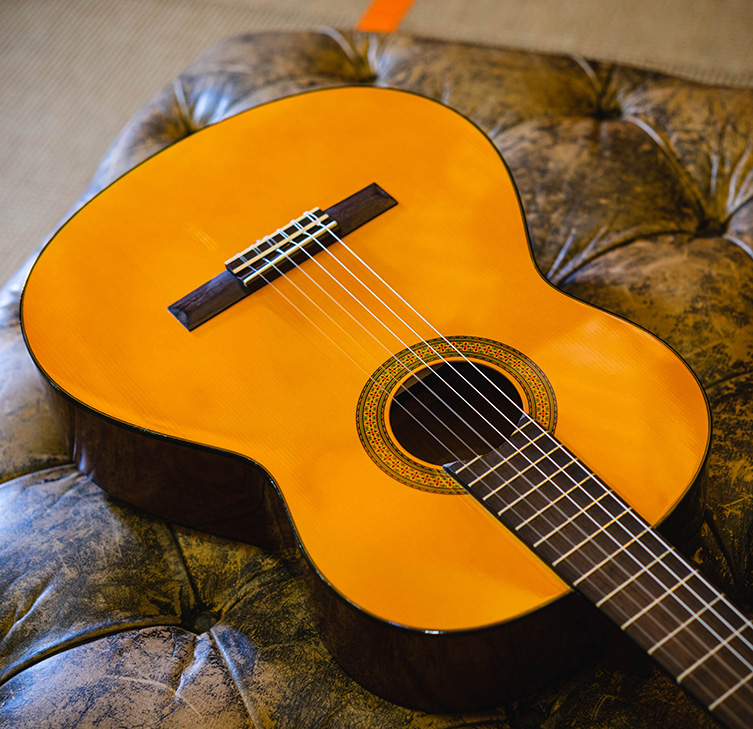
The big subject to address here is the notion of solid timbers vs plies. You’ll hear the term ‘solid top’ a lot, and that means that the soundboard is a solid slice of timber, but the rest of the body is made from plies of wood (of a number of varieties). This is a good cost-effective way to get an upgraded sound, since we know now that the top does most of the heavy lifting in terms of tone.
A solid top will resonate better than a plywood top, and it’ll also ‘season’ as it ages, sounding better and better. The back and sides won’t add too much to the sound if they are plies, but it’s a more than acceptable compromise if price is a factor. All-solid (solid top, solid back, solid sides) guitars are noticeably more expensive than solid-topped instruments. Lots of cheap classical guitars are made of plywood and it’s pretty obvious when you compare them with solid top and all-solid instruments: they don’t have the colour, the sparkle or the depth.
Volume/Projection
Volume is a pretty important factor, but maybe not for the reasons you’d think. Indeed, many of us don’t want a particularly loud guitar if we are living in apartments with neighbours close by. That said, volume is usually a good indicator of a well-built guitar. Unless we’re talking about jumbo acoustics (which we aren’t) where the large body creates a naturally bigger sound, then volume is usually achieved when a guitar is made in such a way that it vibrates effectively. At all points in a guitar build, frequencies, soundwaves and energy can be lost where there’s a bad join, too much glue, a poorly designed or machined piece, and so on. When a guitar is well put together and made with good quality parts, a certain level of projection is a byproduct.
Tuning
Some things never change. Back in the day, a real tell-tale problem with less expensive guitars was that the tuning would keep slipping. This time-honoured tradition does persist these days, too. It’s one of those signs that corners have been cut somewhere on the guitar, whether with the tuners themselves or an indicator of a more insidious problem.
Naturally, fresh strings will require a period of settling in, when they’ll go out of tune a little, but this is a different situation compared with guitars that just won’t ever stay in tune. Given how (deceptively) straightforward the design of a classical guitar is (I know that’s a massive oversimplification!), if one won’t hold its tuning, then I’d simply say dodge it altogether and go for something that does.
Comfort/Balance
It seems like this isn’t much of a subject to discuss with most guitars, but I’d like to address the comfort issue. We tend to sit with classical guitars in a slightly different way than with steel string acoustics. The classical guitar playing pose has the guitar resting between the thighs and pointing up at a higher angle. This moves everything over to the left somewhat, and you therefore need a guitar that allows this in a comfortable manner.
We don’t tend to get a lot of difference in body size with classicals, though there are ¾, ½ and ¼-sized guitars for younger and smaller people. I’d recommend at least investigating these sizes if you generally find guitars to be on the large side, but I’d also advise that these smaller guitars tend to belong in the more beginner/student area of the market. The ¾ and ½ sizing actually refers to the scale length actually, which is the playable distance of the strings. It doesn’t refer to the size of the body per se, but they do tend to be smaller regardless.
So, you don’t tend to get too much difference in body sizes, but there can be a variety of body depths available, or thickness. Thinner-bodied classicals are designed to be more ergonomic, but do bear in mind that they will have a thinner overall sound. That may be what you want, but it may not be. Try them out!
Scale Length
Classical guitars tend to use a scale length that is slightly longer than what you may be used to. As I noted earlier, the scale length of a guitar is the measurement of the amount of playable string available. On an electric guitar, the two typical scale lengths are 24.75” (which we refer to as Gibson-style) and 25.5” (Fender and indeed most guitars). On a classical guitar, the scale is typically at least 25.6” (650mm) and can be as much as 26” (660mm) depending on the maker.
If you want to tackle a range of styles that includes flamenco, I’d recommend going with 25.6”, because the tension will be slightly less, allowing you to zip around with an easier feel.
If you want to play nothing but classical repertoire, then the extra length (it’s not much!) of 26” gives a tighter, more rigid feel.
Regardless of your stylistic intentions, go with what feels the best to you.

Nut Width
All classical guitars have a wide nut. The nut is the white plastic part that sits between the headstock and the 1st fret, and is a pretty important part of the instrument. A badly cut nut will snag the strings and make your playing life a series of annoying compromises, so it’s worth understanding that, but that’s not really the subject here.
The width of the nut basically determines how wide the whole neck is. As I mentioned, all classical guitars have wider necks than either steel string acoustics or electric guitars. The standard measurement is 51mm, which is almost 10mm wider than a typical Fender!
The wider nut width allows the strings to sit further apart and this proves useful for making chords. Not everyone gets on with the width though, and it is worth knowing that plenty of makers (Yamaha, Alvarez and Taylor for example) offer nylon string guitars with narrower nut widths. This allows for an easier transition from standard guitar to classical guitar.
Features
Cutaways and pickup systems are the main areas I’m thinking about in terms of features. These are pretty normal things in the world of guitars but they aren’t typically traditional, so I’m seeing them as additional features for classical guitars.
A cutaway in the guitar’s upper bout can allow you easier access to the higher frets. It may well be that you never venture that far north on the fingerboard, but certain classical and flamenco repertoire will call for it, so bear that in mind.
Pickup systems allow you to plug the guitar into an amp or PA system/mixing desk for public performances. These come in a variety of designs that may or may not incorporate piezo pickups, microphones and inner-body contact mics. It’s a whole subject unto itself, but here’s my two pence’ worth for today’s context: good pickup systems are not cheap. It’s one area of the guitar building where the cost is justified: a brilliant live guitar sound is often an investment, regardless of your playing ability.
An affordable classical guitar with a pickup system installed will often be a compromise on both sides: the guitar has been made cheaply in order to have the pickup included in the low build price; the pickup system will be an unsophisticated device in order to come in at the right price. As I say, it’s a compromise.
Pickup systems can be bought and fitted to guitars, so I’d maybe say that it’s worth spending your money on the guitar itself if you are on a budget, (in other words, not buying a low-priced ‘electro’ model) and retrofitting a pickup when you need it. Once you get away from the beginner-level instruments, you’ll start to get guitars with pickups fitted that aren’t such a series of compromises. Anything from around £400 upwards will be where you start finding good pickup-equipped guitars.
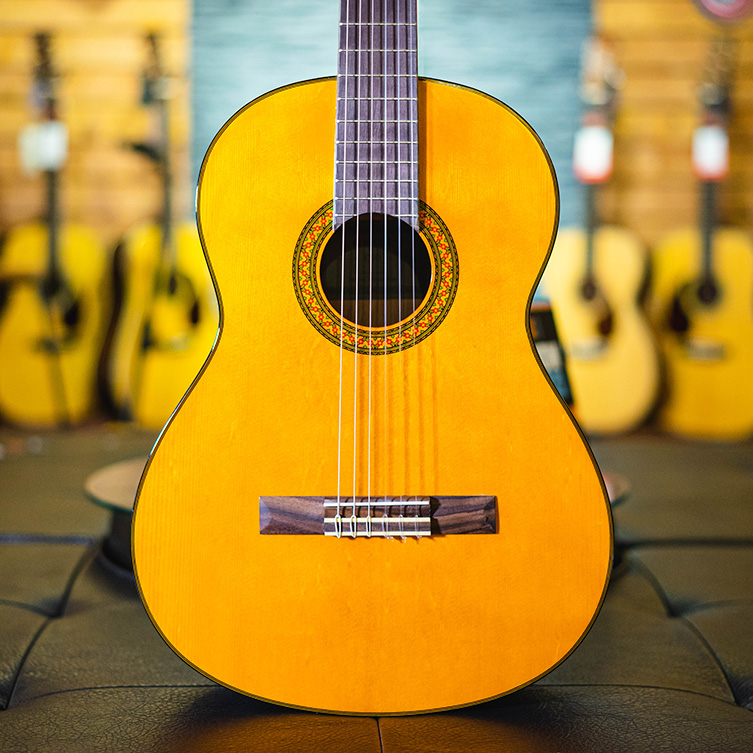
Feel
What does ‘feel’ mean? When we talk about a good ‘feel’ with a guitar, what does it refer to? Put simply, it’s the collective combination of everything we’ve just looked at together. These elements all conspire to give you a certain feel, and that feel will either work for you or it won’t. This is why specs are important, but having hands-on experience of an instrument is the most important. The things I’ve outlined today are all the elements that make up the ‘feel’, and they are the things that are worth having opinions on. You’ll be able to identfty these things you prefer - such as a narrower or wider nut width, for example - from having read this blog and applying the knowledge when trying instruments.
A guitar with good ‘feel’ will sit well on your lap and it’ll allow your hands to sit in the correct places without any trouble. You’ll enjoy the profile of the neck, and when you play a note, it’ll sound out well and resonate. This is the start of the process of getting to know a guitar, and the feel will determine whether you take that process any further.
Which Classical Guitar Should I Buy?
This is the point where I have to leave this up to you. Only you can determine the following:
- How much do I want to spend?
- Do I need a pickup system?
- Do I need a cutaway?
- Will I be upgrading this guitar soon?
- What styles will I be playing?
Once you have answers to these, you can move ahead with confidence. There would be no use in me recommending a particular flamenco model, for example, if you either have no plans to play that style, or if the string buzzing inherent in the design annoys you. This blog has hopefully equipped you with the knowledge to go forward and discern what you want and - just as importantly - what you don’t want!
That said, it would also be remiss of me not to point out some good choices that I’ve encountered along the way. In the spirit of sharing, here are a few nylon string guitars that have impressed me recently. Your needs may differ from mine, so do read why I’m recommending each, and see if it resonates with you!
Best Affordable All-Rounder Classical: Yamaha CG122MC
Calling this a ‘beginner’ classical is perhaps not quite right since it’s over £300 to buy, but I feel like this is what people should buy to learn on. It’s such a decent upgrade over the entry level £100 models that it’s well worth the extra investment. In many ways, this might be enough for a lot of players who want to delve into the classical world on a semi-regular basis.
The main selling points here are the solid Cedar top and the Yamaha build quality. Yamaha are quite strict with their quality control - even at these prices - so it’s a rare thing indeed to encounter any instrument from them that doesn’t acquit itself well. The Yamaha CG122MC is comfortable and highly playable, and the solid top tones are a big step up from plywood guitars.
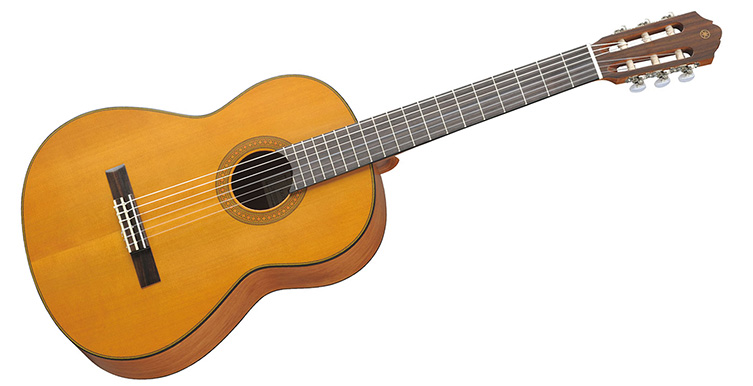
Cordoba Stage Hybrid Classical
Cordoba are steeped in genuine Spanish tradition, and their authenticity spreads to a large number of classical and flamenco guitar models.
This choice isn’t any of those things though! I picked this Cordoba Stage Hybrid model because it represents a fresh ‘way in’ for guitarists who want the classical nylon string sound but either don’t get on with the shape & size of traditional classicals, or want a stage-ready instrument that’s designed to sound good plugged in.
As you can see, this guitar is a good deal shallower in the body than a standard classical. This makes it more ergonomic to handle, but it also stops a lot of feedback issues, since there isn’t a huge hollow space in the body. Also, the neck has a narrower profile (the actual shape and ‘roundness’ as you grab it) and a narrower nut width of 48mm, so it’s a great choice for those who find the physicality of a classical guitar to be too much.
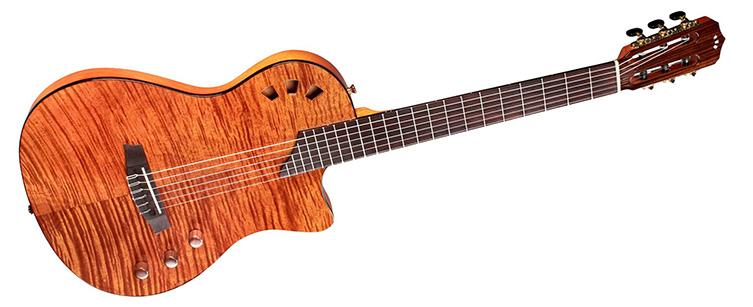
Jose Ramirez Estudio 1
Classical guitars can cost astronomical amounts of money when you get into the handmade Spanish builders. Thankfully, some of the most esteemed builders make guitars that are still somewhat reachable for the dedicated player.
Jose Ramirez are such a brand, and whilst they talk about this as a ‘beginner’ guitar, I’d say that they’re speaking relatively, since their top-end models cost the same as a car! This Ramirez Estudio 1 model is a great example of what I mentioned earlier, about good timbers and great construction quality making for a supremely resonant sounding guitar. It’s cedar and Indian rosewood here, and it’s a combo that brings out some very complex, rich tones. Full of response, this guitar is light on the flash but heavy on the performance.
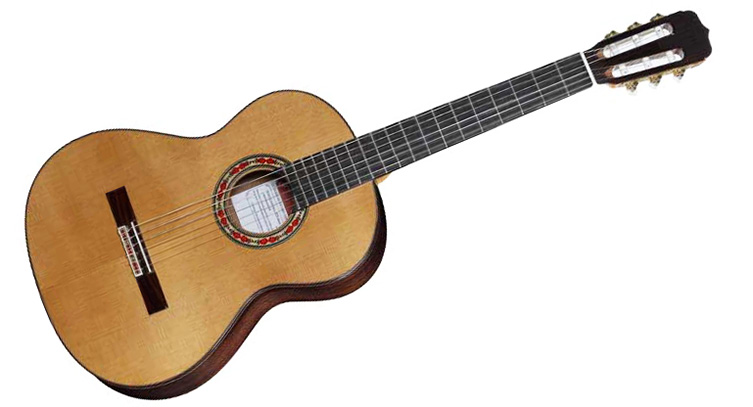
Buy For You
I hope you’ve found this blog useful, and that you now have more of a perspective on what is important to know when choosing a classical guitar. I don’t think it’s a matter of good and bad as much as it’s a case of what best suits your needs and circumstances. Have a browse of our classical guitar stock, and drop in for a shot of a few whenever it suits.



